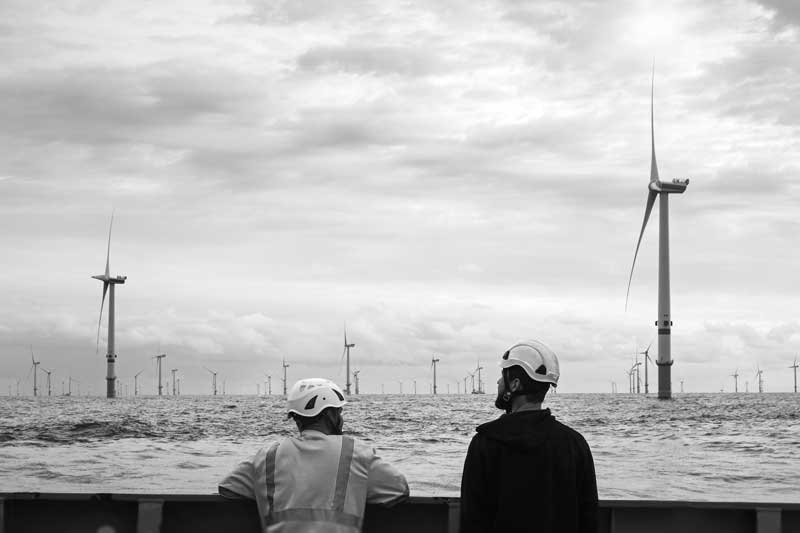By Aaron Du.
Selecting the right fabricator is a challenging task
Empire recently helped a European developer identify and evaluate potential Chinese fabricators for a large scale commercial floating wind development project.
Choosing a fabricator is no simple decision. There are over 100 companies involved in offshore wind fabrication in China East coast. Furthermore, most European developers are not familiar with local Chinese supply chain.
Domestically, offshore wind is growing rapidly in China
The first offshore wind farm in China, Donghai Bridge, was commissioned in 2010. Since then China has built 13 GW of offshore wind farms (to November 2021). In 2020 alone, China installed half of the new global offshore wind capacity.
China has developed its own comprehensive supply chain for offshore wind, including wind turbine OEMs, designers, manufacturers, fabricators, and EPCI contractors. Although the overall offshore wind technology development in China is few years behind Europe, some areas of the Chinese supply chain are becoming competitive in the global market, especially the case with offshore wind foundation fabrication.
This article discusses the advantages and challenges of using Chinese fabricators for offshore wind projects in Europe. A high-level recommendation is also provided.
Talk with a specialist
If you’re considering procuring steel in different markets,
Empire Engineering can advise how to ensure the correct specifications
are implemented, and to ensure Quality is assured.
The advantage of Chinese Fabricators for offshore wind
In the European offshore wind market, the size of the both bottom-fixed and floating foundations continues to grow. The demand is for large size turbines, deep water depths, and harsh sea environmental conditions. In response, the choice of fabricators who have enough space to construct the required large size structures is limited.
In addition, with the rapid pace of development in the Europe offshore wind, the overall capacity of European fabrication firms may not be enough. Put simply, there are just too many offshore wind projects being developed simultaneously. These combined restrictions of fabrication facility and capacity are pushing more and more developers to consider fabricators outside Europe for their offshore wind projects.
The strengths of Chinese offshore wind fabrication are quite obvious: low cost and large capacity. Many people may still think the China’s low cost advantage is mainly because of the cheap labour cost. Beyond this superficial reason, the basis of low cost is the “super-large single market” and the “super large industrial chain”. In China, a large number of specialised suppliers have emerged under various subdivisions of the offshore wind industry and form a network. This super network can quickly meet international needs and is the key competitive advantage.
The shipping cost from Far East to Europe is more expensive than transporting within Europe. However, despite this, the overall cost of fabricating a large set of offshore wind foundations in China remains commercially competitive.

Challenges of using Chinese fabricators for offshore wind
Empire recently undertook an industry survey which indicates that quality, communication, and delivery and are the three major concerns of working with Chinese fabricators.
Quality
Quality of Chinese steel and fabrication is possibly the No. 1 concern of Europe offshore wind developers. There was a quality event of using a Chinese fabricator on the UK Greater Gabbard offshore wind project in 2009. After this incident there followed a period when it seemed there was no Chinese structural steel components used in the UK offshore wind market. However, in June 2020, two Chinese fabricators PJOE, and COOEC-Fluor Zhuhai, signed a contract with Seaway 7 to fabricate 90 of 120 offshore wind jackets for the Scottish Seagreen Offshore Wind Farm.
A consequence of the huge domestic increase in the development of offshore engineering in China has been that many Chinese fabricators have been working to international (US and EU) quality requirements. This has included material, welding, coating, HSE, facility upgrade, and process improvement. In recent years there has been many examples of high standard offshore oil and gas assets (jackets, topsides, FPSO vessels, etc.) which have been built in Chinese fabrication yards and then shipped to Europe. The project owners include top oil and gas operators, such as BP, Shell, and Equinor. This can be viewed as a valuable point of reference. China has a good track record of delivering international offshore engineering projects in accordance with European and International standards.
As part of any evaluation process we need to be aware that the qualities of the 100+ Chinese fabricators are uneven. When undertaking due diligence in the process of fabricator selection, the following aspects need to be considered:
- HSE management system documentations
- Quality management documentation
- Quality assurance leaders’ background and experience
- Size of quality team and capabilities
- Technical authority’s background and experience
- Yard capacities
- Yard facilities
- Fabrication process of various structures
- Load-out and shipping arrangement
- Past project experience
Communication
Some European developers may worry about that the cultural difference between Europe and China could lead to ineffective communication.
While this may be true in some circumstances, nowadays, most Chinese fabricators have a dedicated commercial team dealing with international projects. They hire people who have overseas education and background, understand western culture well and speak fluent English. This can become very helpful along the full cycle of the project.
It is however important to know that Mandarin is the working language in the industry. Many engineers or technicians who work on the project or even in charge of the technical and quality aspects may not be good at speaking or writing in English. This may result in inefficient discussions of technical issues during meetings between the European developer and the Chinese fabrication contractor. The risk of miscommunication could be crucial for project quality and delivery.
Recommendations
For a European offshore wind project fabricated in China, a European developer may well consider the option of using an independent consultant to identify and screen potentially qualified fabricators as part of a due diligence process.
During the project execution stage, the developer may also consider involving a qualified Owner’s Engineer to oversee the quality and process of the fabrication in China. This qualified Owner’s Engineer should fully understand the European project criteria and support the fabricator to digest the fabrication specifications. They should also be familiar with local China offshore wind supply chain, identify potential quality and delivery risks, oversee the QA/QC process, and… ideally speak Mandarin.
Empire has has mandarin speaking specialists based in both UK and China offices who can support Europe offshore wind developers identifying qualitied Chinese fabricators and working effectively with Chinese suppliers. To find out more, please get in touch with Aaron Du who heads up the Empire London office.


